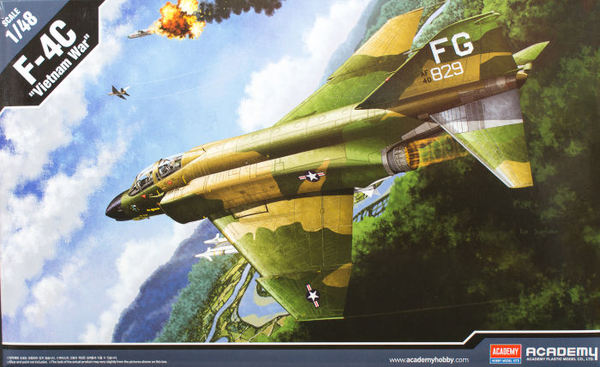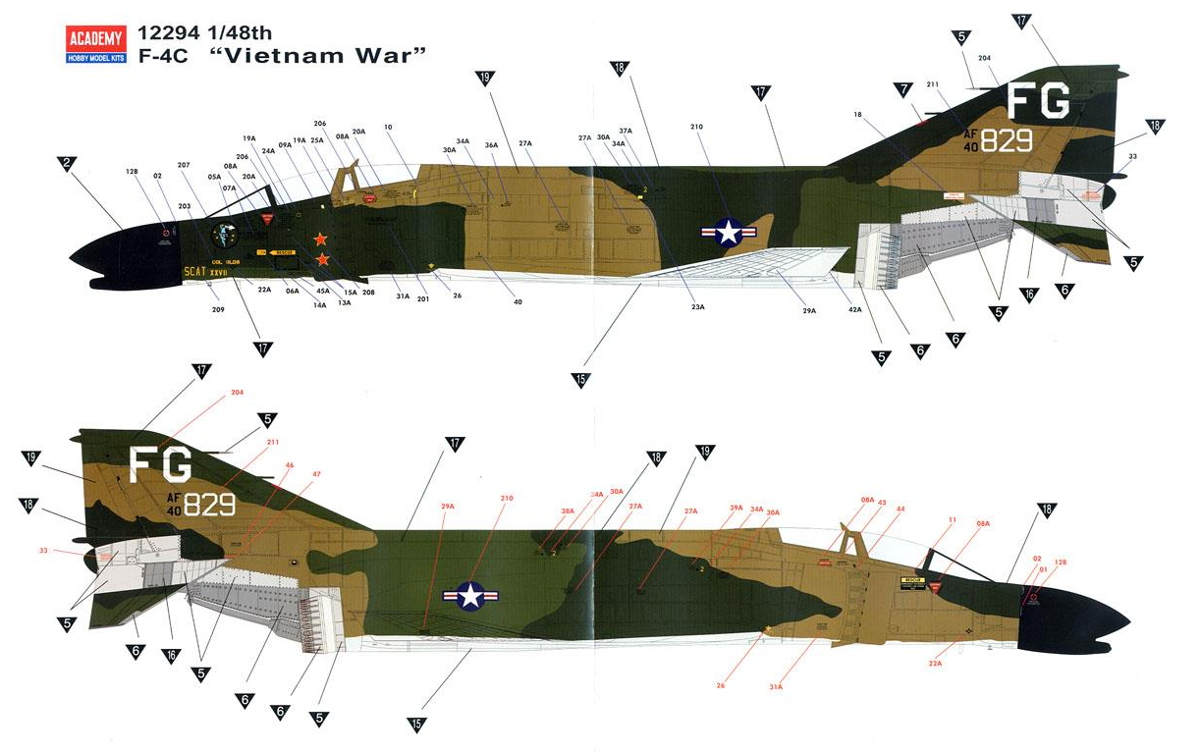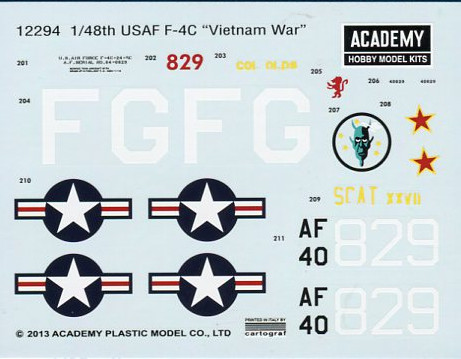
Academy 1/48 F-4C Phantom "Vietnam War"
By Jacob Russell
The Plane
The McDonnell F-4 Phantom was a useful and versatile aircraft that equipped both the United State Navy and later the Air Force during the 1960s and 70s, and it gave sterling service during the Vietnam War. The Phantom was an excellent performer: it flew faster, further, higher and it could carry more ordnance than any other USAF fighter. The Air Force originally called it the F-110A but soon settled on the Phantom name; the F-4C was the first Air Force version.
The Kit
The kit consists of 500 parts on 16 sprues, molded in white, black, blue-gray, gray and clear plastic. My initial impressions of the kit are favorable. Surface detail is by way of recessed panel lines, rivets and raised panel lines, where applicable.
The panel lines are of a consistent depth. There is minimal flash on the parts and very small ejector pin marks; happily most of these are easily removed. The sprue attachment points are located where it's easy to remove the parts without marring them. There are sink marks on parts such as the side of the Martin Baker Mk H7 ejection seats, but they will be invisible due to their location deep in the cockpit.
The cockpit is a multi-piece assembly. It is very well detailed and it will benefit from careful detail painting and dry brushing. The kit includes 3 figures, a standing pilot and a pair of seated pilot and co-pilot figures. If you're confident in your figure painting skills by all means have a try. If not, I would leave the figures alone and instead purchase a seat of photo-etched ejection seat harnesses.
The seats are well done and harnesses will enhance them nicely. As long as you've got your wallet out I would also buy of a set of Mike Grant Jet Era Cockpit decals. The instrument panel faces are blank and they need the enhanced detail (instrument faces, placards, etc.) the decals will provide.
The fuselage is a single molding that faithfully captures the Phantom's complex shape. The lower wing is a single piece to which the upper wing halves attach. Before putting the wings together, assemble the multi-piece wheel wells and glue them to the lower wing.
The wheel wells and landing gear assemblies are very well done and a set of brake lines will add useful detail. The landing gear doors, wheels, air brakes, flaps, etc. are also well depicted. The exhaust nozzles of the General Electric J79 jet engines are well done.
They are molded in black, so if Alclad is your preferred paint for depicting natural metal surfaces you might not need to prime the parts beforehand. If you enjoy depicting extensive weathering you'll have a field day painting the exhausts and aft fuselage as the Phantom is famous for the discoloration of this area.

The under wing stores are extensive. They include a pair of 370 gallon wing tanks and a 600 gallon center line tank, AIM-7 Sparrow missiles, AIM-9M missiles and M117 750 pound bombs. The bombs and missiles mount on a pair of underwing pylons. The pylons include optional triple ejector racks (TER) that allow 3 bombs to be carried on each pylon rather than a single bomb.

Academy's instructions are well illustrated, with a clear and logical build sequence. Color callouts are for Humbrol, Gunze, Lifecolor, Testors, Revell and Vallejo paints. I hope you enjoy decal application, because there are over 240 stencil decals to apply. There is a single decal option, that of Col. Robin Old's 2 MiG kill "Scat XXVII", in the familiar SEAC (South East Asia Command) green/brown camouflage
Conclusion
I'm not an expert on the Phantom, but I think that this Academy F-4C kit is a good depiction of the real thing. It has very good detail, it appears to be accurate, and it features a full complement of under wing stores. I think the kit needs a little aftermarket help (Mike Grant instrument panel decals and a pair of etched seat harnesses) to obtain the best results. I recommend this kit and I would like to thank Model Rectifier Corporation for providing the sample.
References
F-4 Phantom II in Action, Aircraft Number 65, By Larry Davis, Squadron/Signal Publications, 1984
F-4 Phantom II In Detail & Scale, Part I, by Bert Kinzey, Aero Publishers, Inc., 1981
